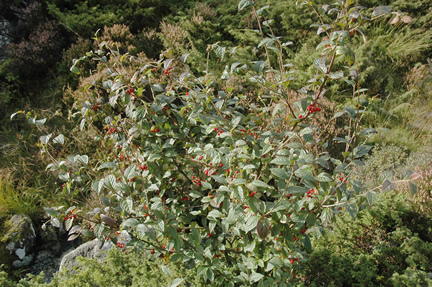
Woody > Cotoneaster > Cotoneaster bullatus > Cotoneaster bullatus
Cotoneaster bullatus
Hollyberry Cotoneaster
Origin: China, first recorded in 1952 by an unknown source.
Mike's
Opinion


"
Known as the Hollyberry Cotoneaster and belonging to the Rosaceae family, Cotoneaster bullatus produces a pale-pink flower and a red-berry that song-birds love. It can be considered as a deciduous shrub or small tree, and is known for its dark red berries that attract many animals and insects. Cotoneaster planting has declined in recent years due to Genus’ sensitivity to diseases and pests, especially fire blight which commonly affects members of the Rosaceae family.
Michael Pascoe, NDP., ODH., CLT., MSc. (Plant Conservation)
"
| Family |
| Rosaceae |
| Genus |
| Cotoneaster |
| Species |
| bullatus |
| Category |
| Woody |
| Type |
| Tree (deciduous), Shrub (deciduous) |
| Pronunciation |
| USDA Hardiness Zone |
| 5a - 9a |
| Canadian Hardiness Zone |
| 6a - 9b |
| RHS Hardiness Zone |
| H6 |
| Temperature (°C) |
| -29 |
| Temperature (°F) |
| -20 |
| Height |
| 2.5 - 4 m |
| Spread |
| 2.5 - 4 m |
Photographs
Description and Growing Information
Flowering Period
| General Description |
| This plant is a deciduous medium-large sized shrub, with dark glossy leaves that turn to yellow and orange colours in the autumn. It has bunches of small pale pink flowers that bloom in the spring, and turn into red berries in the fall. |
| Landscape |
| The Hollyberry Cotoneaster is not a commonly used plant anymore, because of its susceptibility to diseases and pests. But when it is used, it is commonly found in the backgrounds of gardens and along fence lines. Specimens can be found throughout landscapes in the wild, because their seeds are spread out by birds. |
| Cultivation |
| Water Cotoneaster bullatus thoroughly in the first season of planting to help create a healthy root system, after the first year they are fairly drought-tolerant. Use a generous amount of compost and top dressing in the autumn. Prune regularly and cut back dead branches to promote new growth and reduce the chances of being damaged by fire blight fungus during the winter. |
| Shape |
| Large, vertical, and outward-growing shrub, often as wide as it is tall. |
| Growth |
| Medium |
| ID Characteristic |
| Produces distinctive egg-shaped red berries in the autumn. Leaves are oval, simple, and entire. The leaves are dark and glossy, and are also heavily veined; this distinguishes the species from other cotoneasters. The plant is grown for its good-sized foliage and beautiful autumn colours. |
| Pests |
| Plants are very prone to disease; they are a host for fire blight, and are susceptible to scale insects and woolly aphids. |
| Habitat |
| The Hollyberry Cotoneaster tolerates a wide range of soils, and prefers partial sun. They are commonly found along slopes, sparse forests, thickets, river banks, mountain forests and valleys; thrives in altitudes at 900 to 3200 m above sea level. |
| Bark/Stem Description |
| The stems have a small diameter, so the bark isn’t that noticeable. The bark is slender and a purplish colour, older stems turn to a dark brown. |
| Flower/Leaf Bud Description |
| Buds are medium-sized, they overlap, 2 outer bud scales are parted and expose the hairy interior of the bud. The Buds are brown to grey in colour and are usually oppressed. |
| Leaf Description |
| Cotoneaster bullatus branches are usually found with 55 - 90 x 26 - 46 mm leaves, the leaves have distinctive veins that are full and oval in shape. The leaves have a dark and glossy look. The leaves assume a purplish tinge in the winter. |
| Flower Description |
| Flowers are usually 7 - 8 mm in diameter, and pinkish in colour. The flowering period for this plant is from May to June. |
| Fruit Description |
| Cotoneaster bullatus produce cranberry-like fruits that attract many different types of birds. They are 7 - 8 mm, and usually produce 5 seeds. The fruit is inedible to humans, and may cause vomiting and nausea if consumed. |
| Colour Description |
| Large shrub, it bears a dark green foliage in the summer that turns to a red and orange in the autumn. The flowers are a pale pink that produce a bright red berry in the autumn months. |
| Texture Description |
| Medium. |
| Propagation |
| It is recommended to propagate a Hollyberry Cotoneaster using a soft wood cutting method during the early summer. Rooting hormone use is highly recommended. Birds are also the number one source for propagation of fruit-producing Cotoneasters; the reason is because they eat the distinctive red berries that carry the seed. |
| Ethnobotanical Uses (Disclaimer) |
| There are no known ethnobotanical uses for the Cotoneaster Bullatus; its fruits are inedible to humans but attract many birds. |
References
Dirr, M. (2007). Manual of woody landscape plants: Their identification, ornamental characteristics, culture, propagation and uses (6th ed., p. 331). Champaign, Ill.: Stipes Pub.
McVicar, J. (2003). Seeds: The ultimate guide to growing successfully from seed (p. 177). Conn.: Lyons Press.

.jpg)
.jpg)